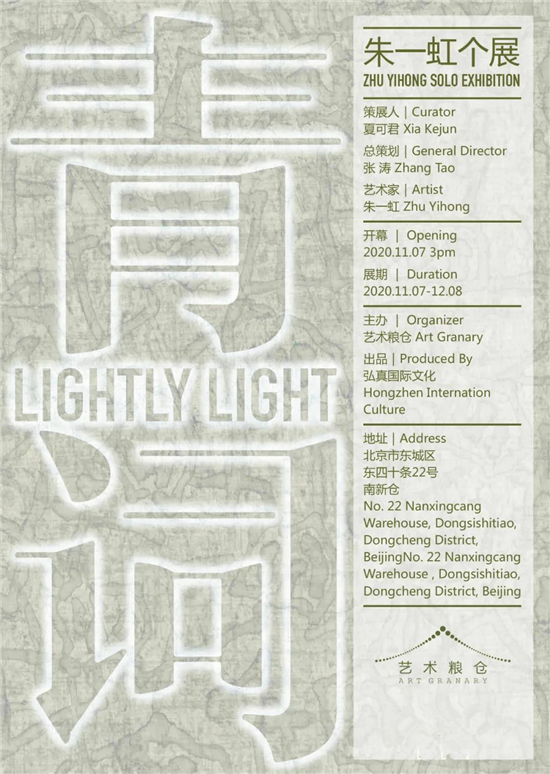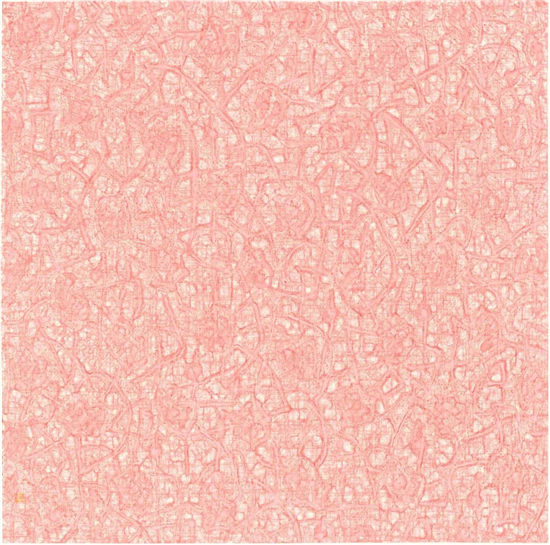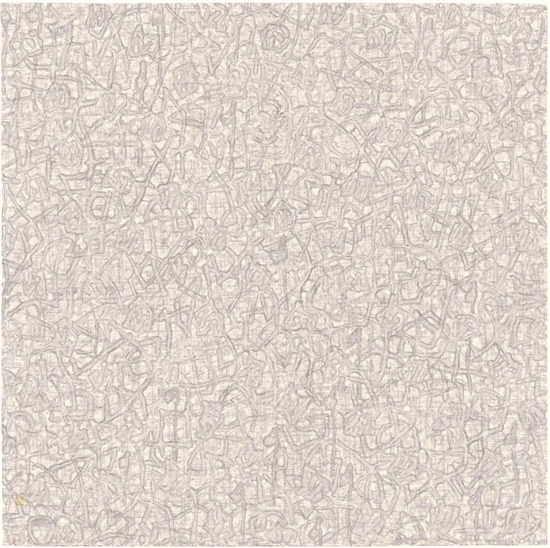
策展人|Curator
夏可君 Xia Kejun
总策划|General Director
张 涛 Zhang Tao
艺术家|Artist
朱一虹 Zhu Yihong
开幕 | Opening 2020.11.07 3pm
展期 | Duration 2020.11.07-12.08
主办 | Organizer
艺术粮仓 Art Granary
出品|Produced By
弘真国际文化发展有限公司
Hongzhen Internation Culture Development co.LTD
地址|Address
北京市东城区东四十条22号南新仓
BeijingNo. 22 Nanxingcang Warehouse ,
Dongsishitiao, Dongcheng District, Beijing
朱一虹的满幅绘画:青词无尽
夏可君
中国绘画的秘密从来不是去描绘什么,而是传达物象的神魂,哪怕是线纹与图案也是如此,在日常持久的工作中,绘画就成为一种黙化的修行,直至进入一种默祷的内在观照,如此带有宗教信念一般的日常书写,就让绘画成为一种修行的劳作。进入现代性,也许只有中国艺术家才如此把修行与工作内在结合,绘画就成为生命修真过程的见证。
当你看到朱一虹的绘画,看过去都是线纹:满幅,单色,缠绕,叠加,绵绵无尽,看似已经完成,却永远在重新开始,看似盘根错节、密不透风,但又暗光浮动、间隙通透。

横塘赋·月花
2018纸本水墨
124×248cm
朱一虹把这些作品命名为《妙法莲华》,它的原初形态来自于“残荷”:一方面借用了荷花的佛教寓意,但仅仅是救赎图像的暗影,只是荣枯轮回又生生不息的暗示;另一方面,这是残荷,被赋予了现代性的残碎感,残荷的倾倒与衰败不可避免,这是生命脆弱的绝对形态;但同时,面对生命不可抑制的衰败形态,面对现代性的虚无主义危机,残荷的自然废墟如何还启发救赎的逆觉?艺术正是要生发出一种抵御的生长力量,因此这些残荷彼此扶持,彼此交织,岁月与光阴就编织其间,如此大千世界的相互扶持,生命的韧性得到绵延,生命的短暂获得了轮回的重生。

妙法莲花
2020
69×69cm
纸本水墨
衰败与重生,消亡与轮回,如此双重力量的对峙与交织,形成了绘画的内在生命力感。这满幅的画面,一个个局部看过去,不就是一个个的“心结”?一次次的“回心”?不就是曼陀罗花最初的“坛集”与“凝心”?朱一虹的绘画乃是“心画”,是满心而发的祈愿连祷。
回心与回光之画,内在绵延张力的充满,就让绘画成为祈祷,成为祈愿,如此心念的编织,按照残荷在衰败与重生之间的转折,线纹开始交织,蔓延与生长,在折断与折回,交织与错杂之间,形成“杂文”一般的“文本”,如同花纹图案,或好像篆书文字,或者就可以看做抽象的格子,或好似无法走出的迷宫。
其实,它们体现出中国文化“似与不似之间”的拟似性原理,但更为靠近不相似的抽象,如同艺术家自觉认识到的,花也非花,叶也非叶,书也非书,一切仅仅是“余象”,是事物“余影”的浮现,这就打破了传统图案的装饰性和对称性。而且绘画具有现代人生命情绪的真实性,看似心乱如麻,但其呼吸的节奏,却纯一透明,这也是为何艺术家要保持单色的缘故。

妙法莲华 20×31
2020
纸本水墨
34×34cm
整个画面在单色的气氛中保持着呼吸的宁静,更像艺术家个体书写的“经文”,也许艺术家就是一边在默念着阿弥陀佛中,一边在书写编织着线纹,这是气息的经文,是不可见的经络或血脉的呼吸转化。
因此,朱一虹的绘画不仅仅是绘画,而是“经书”,从残荷开始的编织,简化为纹理的书写,一切仅仅是余象与余影,无尽地交织,似乎永无穷尽,心思绵延,念愿无尽,一念三千,漂浮的灵光暗暗流动,这才是朱一虹绘画的秘密,来自于工作方法与心性修炼合一的见证。
朱一虹来自山青水秀的江南,自己生活的家乡处处种着荷藕,而且村村都植着莲花,春夏秋冬的轮回中,青红黄褐也在变化,生命的无常变灭,只有付诸于艺术的色调与回心的流光,才可能获得安慰,他选择“残荷”作为个体生命记忆的密码与基元,还在其中融入了无数记忆的褶痕。

妙法莲花
2020
纸本水墨
69×69cm
青词之为青色,是一种生命记忆,也是一种文化记忆,还是一种救赎记忆。带着童年家乡咔叽土布的青色,还有青花包裹的温情记忆,呼吸祖母呵护的余温,荷叶由青绿盛开到枯黄衰败,不断接纳与容纳青色的文化记忆,走向青瓷色的玉质感,走向单色的纯净高贵,走向内心洗涤的宁静。
因此,“青”不仅仅是青颜色,而是普遍化的“青词”,“青词”是绘画之为“丹青”的雅致别名!青词就不再仅仅是道教的祈愿之辞,而是一种生命宁静的提示,满幅的青词吟诵,就如同佛教绵绵不绝的祈祷,构成纷乱世界中最为微妙的“静”气底色,无处不在的暗香之气,与柔韧之力融合后的流光,在无尽的涌动。
Zhu Yihong: No End to Painting
The purpose of Chinese painting is not to depict, but to express the spirit of objects in terms of lines and patterns. Therefore, painting is an unconsciously spiritual practice for artists in every normal day, so religious that it is even like a consistent prayer in heart. In an era today, perhaps only Chinese artists will integrate their spiritual practice into physical exercise and let painting witness the spiritual journey of life.
When looking at Zhu Yihong's paintings, you will see lines all over. The paintings are full of monochromatic lines, which are intertwisted with each other, endlessly. They seem to end somewhere, but actually extend from there. They seem so closed and impenetrable, but actually are constantly interacting with each other.
Zhu named these paintings as Saddharma-Pundarika-Sutra because they are based on the idea of withered lotus flower. In one aspect, it borrows the symbolic meaning of lotus flower from Buddhism, which indicates the shadow of redemption images and the rotation of life; in another aspect, the withered lotus flower is added a sense of fragmentation of modern art. The falling and decaying of a lotus flower are inevitable. They are the settled states of vulnerable life that guide us to think about how can remains of lotus flower inspire a final glimpse of redemption in face of the inexorable decay of life and post-modern nihilism. It is Art, however, that provides a growing power against them and particularly it is these withered lotus flowers, supporting each other and intertwining with each other, that weave numerous days and hours into the paintings. Their mutual support in a cosmos shows remarkable resilience of life and signifies human beings in the cycle of birth, death, and rebirth.

妙法莲花 18F8H
2020
纸本水墨
124×124cm
The inner vitality of painting exactly derives from the confrontation of degeneration and regeneration and the combination of dying out and showing up. With a partial view of these paintings, isn't every part of them a knot in heart? Isn’t it a return to the heart? Isn’t it the joint efforts of datura flowers? Zhu's paintings are the painting of heart with genuine prayer.
For Zhu, to return to the heart and to expand and glow is to make painting a daily prayer that is delicately presented by lotus flowers in a circle of degenerating and regenerating. Their lines, which are intersecting, spreading and growing, breaking off and folding, form essay-like texts, which are not only like patterns, or seal script, but also like a maze consisted of abstract grids that traps the lost.
In fact, these paintings embody the principle of among similarity and dissimilarity in Chinese culture. But they are made more abstract than concrete; that is, they are made more dissimilar to real objects, because the artist consciously realizes that a flower is not a flower, a leaf is not a leaf, and a text is not a text, and all of them are just remains and shadows of objects. This idea breaks down the decorativeness and symmetricalness of the traditional pattern. Moreover, the paintings could pass on the genuine emotions of modern people whose mind seem like in a turmoil, yet whose rhythm of breathing is simple and transparent. That is the reason why the artist keeps the paintings monochrome.

妙法莲花
2020
纸本水墨
153×84cm
In a monochromatic atmosphere, the whole painting keeps rhythmic breathing silently, like a sutra written down by the artist. Perhaps they are created in the artist’s chanting. Lines stretched and invisible meridians and blood vessels transform in the sutra of breath.
Therefore, Zhu’s works are not just paintings, but sutras. The process of weaving withered lotus is simplified as that of writing down textures that are made up with remains and shadows that are eternally interwoven together in endless thoughts and countless wishes. That are his unique magic—the thoughts and wishes out of the integration of spiritual practice and physical exercise.
Zhu comes from the Jiangnan area, where every family grows lotus roots and every village grows lotus flowers. Lotus changes in the rotation of seasons, from green to pink, then from grey pink to brown. The impermanence of life implied by lotus can only be complemented by the hues of art and the return to the heart. He chose withered lotus as the basic code of individuals’ memory about life, and incorporated countless memory folds into it.

妙法莲花组画(可分可合)
2020
纸本水墨
69×69cm×9
Indigo blue on the paintings represents memories about life, about culture and about redemption. For Zhu Yihong, indigo blue is cotton clothes from his hometown, sweet memories wrapped in blue and white porcelains, and warm care from grandma. With these memories accompanied by lotus, he continues to accept culture of indigo blue, the jade texture of celadon, the pure nobility of monochrome, and the tranquility of heart.
Therefore, indigo blue not only refers to a kind of color, but also represents Qingci, an exquisite name of painting. The ubiquitous aroma of dark incense and the flow of light from the fusion of pliability and strength are endlessly surging. It is then not just a Taoist prayer, but a reminder of the tranquility of life. The chanting of indigo blue, as constant as a Buddhist pray, forms the most subtle ground color of stillness in a chaotic world with the ubiquitous aroma of dark fragrances and the flowing light of flexibility.
艺术家简历

朱一虹 1954年生于浙江永康, 文化周刊主编,现专职水墨研究。
2020 GFAA2020嘉德典亚艺术周 艺术粮仓 北京
2020 【心象】当代水墨艺术展 艺术粮仓 深圳
2020 ART深圳 艺术粮仓 深圳
2020 【线中线】黑白主义第一回 艺术粮仓 北京
2019 ART TAIPEI台北当代艺术博览会 台北
2019 第一道光·艺术际遇
2019 当代水墨十人展
2019 【玉生烟】墨化系列第四回 艺术粮仓 北京
2018 新现代水墨艺术宣言
2017 水墨论坛邀请展
出版有《山水一虹》《在路上》

艺术粮仓一直致力于将中国传统文化艺术—水墨艺术融入当代语境,以严谨的学术态度,与专业的策展人、评论家合作,共同策划呈现中国当代水墨系列展览及大量学术研讨活动。作为国内前沿的艺术机构,艺术粮仓通过与艺术家的深入合作,系统的呈现了中国当代水墨的当代性、国际性、未来性,力求让世界更好地认识到中国当代水墨的东方气质和艺术价值。
